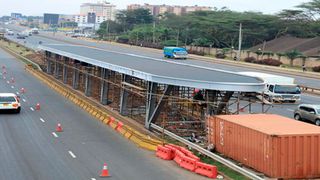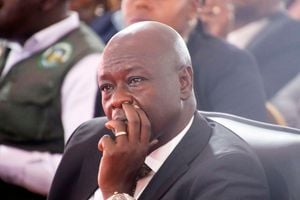
A Bus Rapid Transport (BRT) station under construction along Thika Road at Safari Park footbridge by the Kenya National Highways Authority (KeNHA) in this photo taken on June 4, 2021.
| Jeff Angote | Nation Media GroupNairobi
Premium
No BRT until next year, metro transport agency says
Nairobi residents will have to wait a while longer before they can start using the Bus Rapid Transit (BRT) system, the Nairobi Metropolitan Area Transport Authority (NaMATA) has said.
BRT, which was to start operations by the second half of this year, has now been pushed to February 2022, NaMATA Director-General Francis Gitau has said.
Speaking to Nation.Africa, he blamed the Covid-19 pandemic for the delay but insisted that residents will start enjoying BRT buses by early next year.
“The Thika Road BRT, which is government-funded, saw the communication plan delayed due to Covid-19 as we could not congregate like before. This led to shifting everything close to a year. But now we are moving forward to see it completed by February 2022,” he said.
A park-and-ride facility is being set up at Kasarani, where motorists heading to the city centre can leave their vehicles and use BRT buses for the remainder of the journey.
A Bus Rapid Transport (BRT) station under construction along Thika Road at Safari Park footbridge by the Kenya National Highways Authority (KeNHA) in this photo taken on June 4, 2021.
Unveiled in phases
The project is being unveiled in two phases. The first is between Clayworks, through the city centre and on to Kenyatta National Hospital (KNH), while the second starts from Clayworks to Ruiru.
There will also be a bus terminal at KNH, and depots in Kasarani and Ruiru, as well as a transfer station at the Nairobi Railway Station. Along the corridor will also be non-motorised transport.
Last year, Stecol Corporation, previously known as SinoHydro Tianjin Engineering Company Ltd, signed a memorandum of understanding to build the long-awaited BRT system, which is expected to support the city’s rickety public commuter services and help ease traffic congestion.
The project starts from the KNH Terminal to the Ruiru Station Depot, about 27km in length. The dedicated BRT line length is about 20.18 km.
Mr Gitau said that along the line, there will be 13 intermediate stations with 24 platforms (two-line transfer stations reserved for future lines that are not counted in this project) and KNH Terminal, Ruiru Depot, Kasarani Depot.
“Ten existing footbridges are currently being modified by adding staircases in the middle to allow for passengers entering and exiting the stations,” he added.
A Bus Rapid Transport (BRT) station under construction along Thika Road at Safari Park footbridge by the Kenya National Highways Authority (KeNHA) in this photo taken on May 19, 2021.
So far, work on designated BRT stations is underway at Garden City, Safari Park, Roysambu, Clayworks, Kahawa Barracks and Kenyatta University.
Bus rapid transit takes its name from rail rapid transit, which describes a high-capacity urban public-transit system with its right of way, multiple-car vehicles at short headways, and longer stop spacing than traditional PSVs and buses.
BRT uses buses on a wide variety of rights-of-way, including mixed traffic, dedicated lanes on surface streets, and busways separated from traffic.
Express lanes
Transport Cabinet Secretary James Macharia explained to Nation.Africa that the buses will use the express lanes after picking up passengers in estates with the first drop-off being in the city centre.
The same will apply for the buses in the evening, as they will only carry passengers who are heading to estates and not planning to alight along the highway.
The Ministry of Transport then explained that the lanes will be used by high-capacity buses carrying 80-plus commuters.
Many people, however, questioned why markings have been made on the innermost lanes while passenger service vehicles (PSV) would use the far right lane when the rule is to keep left in Kenya.
Mr Gitau explained that the electric passenger buses that will be procured through a public-private partnership (PPP) will have doors on both sides so that they can also use cab services and median services.
“There may come a time when our buses may operate in mixed traffic and also on dedicated so we will have buses that are fitted with doors on both sides.”
A Bus Rapid Transport (BRT) station under construction along Thika Road.
Dedicated bus lanes
BRT typically operates using dedicated bus lanes, while passengers pay their fares before boarding with the system combining the flexibility of bus transit with the speed, reliability and capacity of rail systems, at a fraction of the cost.
The Thika BRT will see the buses share the road with other vehicles but they will have a designated inner lane of the road and will not be separated physically from the general traffic lanes.
Each bus is expected to have a capacity of about 160 passengers, who will use electronic cards for payment.
Mr Gitau also said that the mass transport project will engage 100 buses in the initial phase before scaling up operations progressively.
“We have done all the necessary studies and engaged all the stakeholders with a national outlook, including matatu associations, on the plan which will now give them a chance to be major players through an operating company which will be contracted to run the services,” he said.
“What we want is a reliable and efficient mass transit system that will attract even those using private vehicles to use.”
Only electric passenger buses allowed
Charles Hinga, the principal secretary in the State Department of Housing and Urban Development, last week said that only electric passenger buses will be allowed on the lane, in the plan intended to decongest the busy highway.
“We’re making good progress. The fabrication of stations is ongoing, and park ‘n’ ride facilities, bus depots, a command centre are all under construction. Electric buses will be procured via a public-private partnership (PPP),” Mr Hinga said in an interview. But no date has been set for the launch of the Thika Road BRT system.
The high-capacity electric buses, Mr Hinga noted, are expected to reduce the cost of public transport as they will be cheaper to operate, attract cheaper financing and reduce the country's carbon footprint.
The stations have been designed in such a way that entry and exit from the stations are through a footbridge, which means passengers will not have to worry about crossing vehicle traffic lanes. The plan also leaves little room for commuters to slip or sneak through motorways.
“The stations have taken care of everyone. There is a ramp to get to the top of the footbridge and a special lift to take wheelchairs down or up the station. In other words, there is universal access,” he said.
Operated by private sector
He also confirmed that the BRT system will be operated by the private sector, not the government. It is, however, still not clear who will own the buses.
The Kenya National Highways Authority is overseeing the 5.8 billion project, one of the five BRT system corridors planned in Nairobi.
In January, NaMATA released a schedule for the long-awaited BRT system, which contained the time and routes the BRT buses will ferry commuters to and from the city centre.
NaMATA said it will first deploy buses across five city routes that have been allocated lines - Ndovu, Simba, Chui, Kifaru and Nyati.
The authority has pushed for the approval and gazettement of the five-node BRT network that will see commuters enjoy hourly bus services.
NaMATA’s five routes will cover the city centre, Kenya’s financial hub of Upperhill and straight into various estates.





